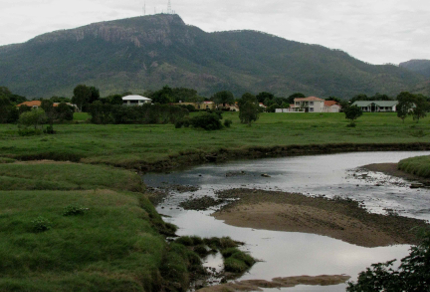
Bush Stone-curlews (© Magi Nams)
In late afternoon, cloud like purple cotton batten painted a soft backdrop for flaring palm fronds and soaring rain trees. A myna chirped and muttered from an overhead wire, while a yellow-throated miner repeated its questioning ‘whit?’ Heat radiated off the Ross River Parkway path, brushing my legs with warmth that collided with higher, cool air and specks of rain. A pair of bush stone-curlews rested beneath a tree on the golf course, one with half-closed eyes, as though dozing after its night of haunting the greens with its wails. Only sporadic bird calls dented the afternoon quiet – burring trills of rainbow bee-eaters that banked through the air with their cinnamon wings taut triangles attached to blue-green bodies, the liquid ‘dollop!’ of a friarbird, and the abbreviated rattle of a masked lapwing. A pair of rock doves flirted in the air, and white ibises arrowed across the sky with rapid wingbeats. Ahead of me on the street, a white ibis dipped its sickle-shaped beak into a foil VB chip bag labeled ‘The Best Hot Chip made for the Best Cold Beer’ while an Australian magpie looked over its shoulder.

Ross River, Annandale, and Mount Stuart, Townsvielle (© Magi Nams)
Rush-hour traffic on Bowen Road slid along in slow-moving lines of white vehicles, with a few brightly-coloured cars added to the mix. Frangipani leaves lay fallen into twisted brown scoops near the underpass, and shorn grass formed patchy brown stubble adjacent to the path. The fishos’ paths out to the river stretched through once-flooded tidal lagoons like curving fingers pointed at the river’s exposed bank. I looked across the river to the new, upscale suburb of Annandale and envisioned that level plain at the base of Mount Stuart fenced into holding pens for cattle that stirred dust into rising clouds and rent the air with agitated bellows while being herded to the meatworks in Idalia, as they were during the late 18th and 19th centuries (see http://maginams.ca//2010/04/18/ ).
Uncannily, my historical imaginings of the afternoon dovetailed with an evening seminar Vilis, Janis, and I attended at the CityLibraries branch in Aitkenvale, the topic of which was ‘Archaeology of the Townsville Region.’ The talk was presented by Drs. Shelley Greer and Kim Owen of JCU’s Schools of Arts and Social Sciences and Medicine. The two presenters stressed that archaeology is the search for physical evidence of past human occupation – items that were discarded or lost – rather than accounts written from a particular viewpoint, which is the realm of history. Both researchers are involved with investigating the archaeology of the period of Townsville’s settlement by Europeans. Dr. Greer described how their studies have focussed on the West End and Belgian Gardens Cemeteries, the Eureka and Range Hotels in Herveys Range, and mostly recently on the Central Flinders Street Area, where they hope to determine why the city of Townsville started to move west after it was established.
We learned from Dr. Greer that cattle were, in fact, the primary reason Townsville was established by John Melton Black and Robert Towns in 1864, since the Burdekin River posed an impassable barrier during the Wet for drovers moving cattle south to the port of Bowen. Thus, a new port was needed in North Queensland, and Black and Towns chose the mouth of Ross Creek to be that port. Dr. Owen described how wharves, stores, warehouses, shops, pubs, and houses soon were constructed alongside Ross Creek. Cotton and sugarcane plantations were started by Melton Black, who also developed shipping and support services for the port and a melting down works associated with processing cattle. The goldfields discovered in North Queensland from 1867 on added impetus to the construction of the Townsville settlement and guaranteed is continued existence as a supply centre. Curiously, old site planning maps showed that the high tide mark extended to the middle of Flinders Street, and Dr. Owen related a story of how a young boy was taken by a crocodile stranded in a puddle on the main street of Townsville after the tide receeded.
Typically, the two archaeologists search for rubbish dumps, graveyards, and other signs of occupation. After a recent demolition of an air-raid shelter in the backyard of Stanton House on Flinders Street East, Dr. Greer and her students found ink jars and glass bottles dating from the 1870’s to the 1920’s, ginger beer bottles from the 1920’s, Hof bricks, and tin address stamps used by Anglican clergy during the time the Anglican Dioscese occupied Stanton House. They also found lead typeset and powdered pigments that likely came from a printer’s shop that had been located next door. After the talk, I asked which artifacts were most valuable for determining specific time periods and was told that the most informative artifacts were coins, glass bottles having distinctive tops or manufacturer’s marks, the backs of plates having a potter’s stamp, nails, and smoking pipes, the last of which often were stamped with a manufacturer’s name and sometimes even the year they were made.
To me, it all seemed like a huge and enthralling puzzle, the pieces of which didn’t come in a box with a photograph on the front, but instead were unintentionally dropped, dumped into heaps of debris, or perhaps tossed over a neighbour’s fence.


